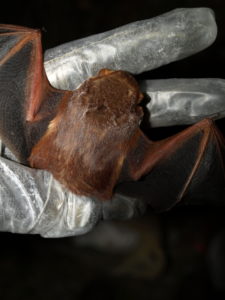Seminole Bat
Scientific Name: Lasiurus seminolus
Description.
Seminole bats typically weigh between 7 and 14 grams, are 44 to 52 mm in length with a wingspan between 108 and 114 mm, and females are slightly larger than males. Due to how similar Seminole bats look to red bats, they were originally thought to be a subspecies of red bats. Seminole bats have a mahogany fur with white/gray tips and a pale brown underside.
Distribution.
Seminole bats are mostly found in the Gulf Coast states with their range stretching from East Texas to the Atlantic Coast and as far north as northern Arkansas and North Carolina. These bats spend the summer months in the northern part of their range and winters in the southern parts. Seminole bats can be found hanging from Spanish moss, loose bark, or leaves in lowland forests with leaf litter lying on the forest floor beneath them to reduce the amount of light reflected on them. Seminoles prefer pine trees specifically for roosting.
Ecology and Behavior.
Seminole bats are a solitary species. Unlike other bat species, Seminoles do not hibernate or go into deep torpor. Weather permitting, these bats will be active during winter months. While these bats are known to make southern migrations, not much is known about how they do so.
Food and Feeding.
Seminole bats typically feed on crickets, dragonflies, bees, wasps, beetles, and flies. They typically feed in places where insects gather, such as forest edges, over open ponds, and near lights.
Reproduction and Development.
Not much information is known about Seminole bats’ mating behaviors, but mating is known to occur during the fall. Females store sperm during the winter with fertilization happening in spring. Females usually have between 1 and 4 offspring and carry out parental care.
Status.
Seminole bats are listed as “least concern.” While there is currently no research to determine whether Seminole bats are affected by humans collecting Spanish moss or not, there’s a chance these collections could affect roosting behavior. White-Nose Syndrome is currently not an issue for Seminoles but their populations are being watched for signs of the disease.
- Click here to see where you can find the Seminole Bat in NC!

